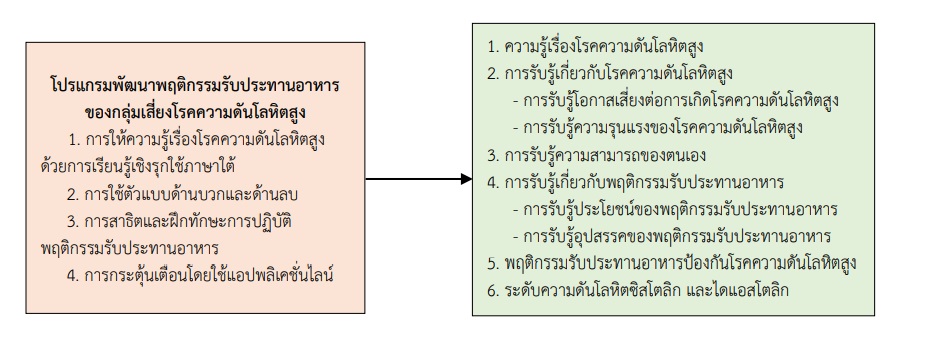ผลของโปรแกรมพัฒนาพฤติกรรมรับประทานอาหารของกลุ่มเสี่ยงโรคความดันโลหิตสูง อำเภอทุ่งสง จังหวัดนครศรีธรรมราช
คำสำคัญ:
พฤติกรรมรับประทานอาหาร, กลุ่มเสี่ยงโรคความดันโลหิตสูง, แบบแผนความเชื่อด้านสุขภาพบทคัดย่อ
การวิจัยกึ่งทดลองแบบ 2 กลุ่มวัดผลก่อนและหลังทดลองนี้ มีวัตถุประสงค์เพื่อเปรียบเทียบความรู้และการรับรู้เกี่ยวกับโรคความดันโลหิตสูง การรับรู้ความสามารถของตนเอง การรับรู้เกี่ยวกับพฤติกรรมรับประทานอาหาร พฤติกรรมรับประทานอาหารป้องกันโรคความดันโลหิตสูง และความดันโลหิตของกลุ่มทดลองระหว่างก่อนและหลังได้รับโปรแกรม และระหว่างกลุ่มทดลองและกลุ่มเปรียบเทียบหลังได้รับโปรแกรม กลุ่มตัวอย่างเป็นกลุ่มเสี่ยงโรคความดันโลหิตสูงที่มีระดับความดันโลหิต ระหว่าง 120/80-139/89 มม.ปรอท เลือกกลุ่มทดลองจากโรงพยาบาลส่งเสริมสุขภาพตำบลบ้านทุ่งควาย และกลุ่มเปรียบเทียบจากโรงพยาบาลส่งเสริมสุขภาพตำบลบ้านทุ่งส้าน กลุ่มละ 30 คน ด้วยวิธีการสุ่มอย่างง่าย เครื่องมือที่ใช้ในการวิจัย ประกอบด้วย 1) โปรแกรมพัฒนาพฤติกรรมรับประทานอาหารของกลุ่มเสี่ยงโรคความดันโลหิตสูงตามแนวคิดแบบแผนความเชื่อด้านสุขภาพ 2) แบบบันทึกสุขภาพ และแบบบันทึกพฤติกรรมรับประทานอาหาร 3) แอพพลิเคชั่นไลน์ 4) แบบสอบถามผลของโปรแกรมพัฒนาพฤติกรรมรับประทานอาหาร และ 5) เครื่องวัดความดันโลหิต วิเคราะห์ข้อมูลด้วยสถิติพรรณนา สถิติทดสอบที สถิติทดสอบวิลคอกซันซายน์แรงค์ส และสถิติทดสอบแมนวิทนีย์ยู ผลการวิจัยพบว่า
1. หลังได้รับโปรแกรม กลุ่มทดลองมีความรู้เรื่องโรคความดันโลหิตสูง สูงกว่าก่อนได้รับโปรแกรมและเพิ่มขึ้นมากกว่ากลุ่มเปรียบเทียบ มีการรับรู้เกี่ยวกับโรคความดันโลหิตสูง การรับรู้ประโยชน์ของพฤติกรรมรับประทานอาหาร สูงกว่าก่อนได้รับโปรแกรมและกลุ่มเปรียบเทียบ มีการรับรู้อุปสรรคของพฤติกรรมรับประทานอาหาร ต่ำกว่าก่อนได้รับโปรแกรมและกลุ่มเปรียบเทียบ มีการรับรู้ความสามารถของตนเอง สูงกว่าก่อนได้รับโปรแกรม อย่างมีนัยสำคัญทางสถิติที่ระดับ .05 แต่ไม่แตกต่างจากกลุ่มเปรียบเทียบ
2. หลังได้รับโปรแกรม กลุ่มทดลองมีพฤติกรรมรับประทานอาหารป้องกันโรคความดันโลหิตสูง สูงกว่าก่อนได้รับโปรแกรมและเพิ่มขึ้นมากกว่ากลุ่มเปรียบเทียบ อย่างมีนัยสำคัญทางสถิติที่ระดับ .05
3. หลังได้รับโปรแกรม กลุ่มทดลองมีความดันโลหิตซิสโตลิก ต่ำกว่าก่อนได้รับโปรแกรม และลดลงมากกว่ากลุ่มเปรียบเทียบ มีความดันโลหิตไดแอสโตลิกต่ำกว่าก่อนได้รับโปรแกรมและกลุ่มเปรียบเทียบ อย่างมีนัยสำคัญทางสถิติที่ระดับ .05
ควรพัฒนาโปรแกรมพัฒนาพฤติกรรมป้องกันโรคไม่ติดต่อเรื้อรังอื่น ๆ ที่มีอุบัติการณ์สูง ติดตามกลุ่มทดลอง ทุก 1-6 เดือน เพื่อติดตามความยั่งยืนของพฤติกรรมรับประทานอาหารป้องกันโรคความดันโลหิตสูงและติดตามคัดกรองกลุ่มทดลองในระยะยาวแบบไปข้างหน้า
เอกสารอ้างอิง
Becker, M. H., Drachman, R. H., & Kirscht, J. P. (1974). A New Approach to Explaining Sick Role Behavior in Low Income Populations. American Journal of Public Health, 64(3), 205–216.
Bloom, B. S., Hastings, T. J., & Madaus, G. F. (1971). Hand Book on Formative and Summative Evaluation of Student Learning. New York: McGraw – Hill Book Company Inc.
Bonwell, C. C., & Eison, J. A. (1991). Acitve Learning: Creating Excitement in the Classroom. Washington, D.C.: The George Washington University.
Chanprasit, C., & Senaratana, W. (2010). Nursing and Health Promotion in Nursing Concept and Process. (13rd ed). Nonthaburi: Sukhothai Thammathirat Open University. (In Thai).
Hosutisima, P. (2018). The Effectiveness of Health Education Program on Hypertension Prevention among High Risk Groups in Jorrakeahin Sub District Khonburi District Nakhonratchasima Province 2560. The Office of Disease Prevention and Control 9th Nakhonratchasima, 25(2), 56-66.
Information and Communication Technology Center, Office of the Permanent Secretary Ministry of Public Health. (2018). Report Group Illness Standards with Important Non-Communicable Disease. Retrieved June 18, 2022 https://hdcservice.moph.go.th/hdc/main/index_pk.php. (in Thai).
Janda, J., Veleminsky, M., Sulakova, T., Prochazka, B., Eliasek, J., & Stransky, P. et al. (2017). Effect of the DASH-Diet and Salt Kardisal on Blood Pressure in Addolescents with Prehypertension. Neuroendocrinology Letters, 38(8), 544-548.
Khumthaweeporn, P., Ronritwiechai, J., Thongcharean, W., & Leehahkun, W. (2015). Phathophysiology in Nursing. Bangkok: T.S.B Product. (in Thai).
Kongvivat, K., Iemsawasdikul, W., & Nuysri, M. (2017). Effects of Preventive Behavior Developing Program for Patients with Cerebrovascular Disease Risk at Kanchanaburi Province. Journal of Nursing and Health Care, 35(3), 129-137. (In Thai).
Lin, P. H., Allen, J. D., Li, Y. J., Yu, M., Lien, L. F., & Svetkey, L. P. (2012). Blood Pressure-Lowering Mechanisms of the DASH Dietary Pattern. Journal of Nutrition and Metabolism. doi.org/10.1155/2012/472396.
Malloy-McFall, J., Barkley, J. E., Gordon, K. L., Burzminski, N., & Glickman, E. L. (2010). Effects of DASH Diet on Pre-and Stage 1 Hypertensive Individuals in a Free-Living Environment. Nutrition and Metabolic Insights, 3, 15-23.
Maneesriwongkul, W., (2016). Behavioral Theory for Community Nurse Practitioner. In Health Policy and Health System, Leadership, Concepts and Theories in Nursing and Community Nurse Practitioner’s Roles. Nonthaburi: Sukhothai Thammathirat Open University. (In Thai).
Non–Communicable Disease Section of Public Health. (2018). World Hypertension League. Retrieved November 22, 2019 http://thaincd.com/document/file/info/non-communicable-disease/. (in Thai)
Nutrition Department of Health, Public Health. (2013). Healthy Alternative Food of Pre Diabetes Mellitus and Pre Hypertension. Samut Sakhon: Born to Be Publishing. (In Thai).
Phetphum, C. (2020). Theory of Planned Behavior. (3nd ed). Phitsanulok: Naresuan University. (in Thai).
Phichayapongsopon, S., & Chulaporn Sota, C. (2018). The Effectiveness of Health Education Program for Health Behavior among Pre-Hypertension, Muang District, Nakornratchasima Province. Thailand Journal of Health Promotion and Environmental Health, 41(1), 57-69. (in Thai).
Phunsuwan, N., Glangkarn, S., & Tewthong, K. (2015). Effectiveness of Change Management Health Beliefs and Health Behaviors Self Risk Essential Hypertension Disease at Kokmamaung Subdistrict, Pakham District, Buriram Province, Thaksin University Journal, 18(2), 70-78.
Sacks, S. M., Svetkev, L. P., Vollmer, W. M., Appel, L. J., Bray, G. A., Harsha, D., et al. (2001). Effects on Blood Pressure of Reduced Dietary Sodium and the Dietary Approaches to Stop Hypertension (DASH) diet. The New England Journal of Medicine, 344(1), 1-10.
Singkharotai, A. (2017). Effect of Health Promotion Program in Groups at High of Blood Pressure by Application of Health Belief Model, Khaopanom Sub-District, Khaopanom District, Krabi Province. Community Health Development Quartery Khon Kaen University, 5(2), 259-279.
Srimorgot, P. (2010). Medical3surgical Nursing: Clinical Management for Positive Outcomes 4th. Bangkok: I Group Press Company Limited. (in Thai).
Thai Health Promotion Foundation. (2019). Food to Reduce High Blood Pressure. Retrieved June 22, 2022 from https://www.thaihealth.or.th/Content/46593. (in Thai)
Thai Hypertension Society. (2015). Thai Hypertension Society: Guidelines in the Treatment of Hypertension. Chiang Mai: Trickthink. (In Thai).
Thunchai, M. (2015). Adult and Hypertension in Elderly Nursing. In Adult and Elderly Nursing. (10nd ed). Nonthaburi: Sukhothai Thammathirat Open Niversity. (in Thai).
Tippawangkosol, P. (Eds.). (2010). Medical-Surgical Nursing Clinical Management for Positive Outcomes 4. Bangkok: I Group Press. (in Thai).
Wichiranon, S., Boonna, P., & Athimuttisan, J. (2012). The Way of Life and Local Food Security in the Southern Part, Journal Science and Technology, 8(1), 94-107.

ดาวน์โหลด
เผยแพร่แล้ว
ฉบับ
ประเภทบทความ
สัญญาอนุญาต
ลิขสิทธิ์ (c) 2023 วารสารการพยาบาลและการศึกษา

อนุญาตภายใต้เงื่อนไข Creative Commons Attribution-NonCommercial-NoDerivatives 4.0 International License.





